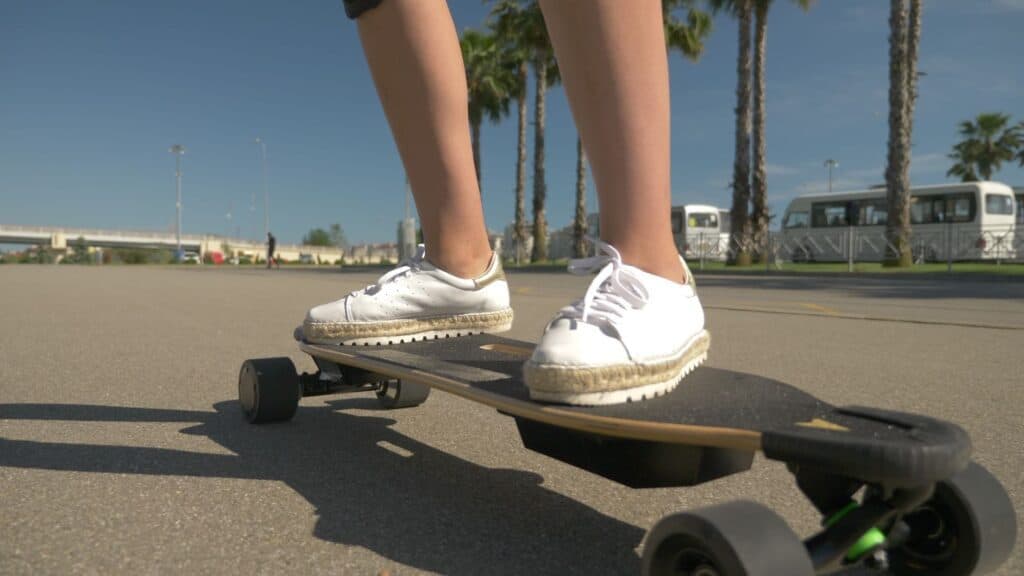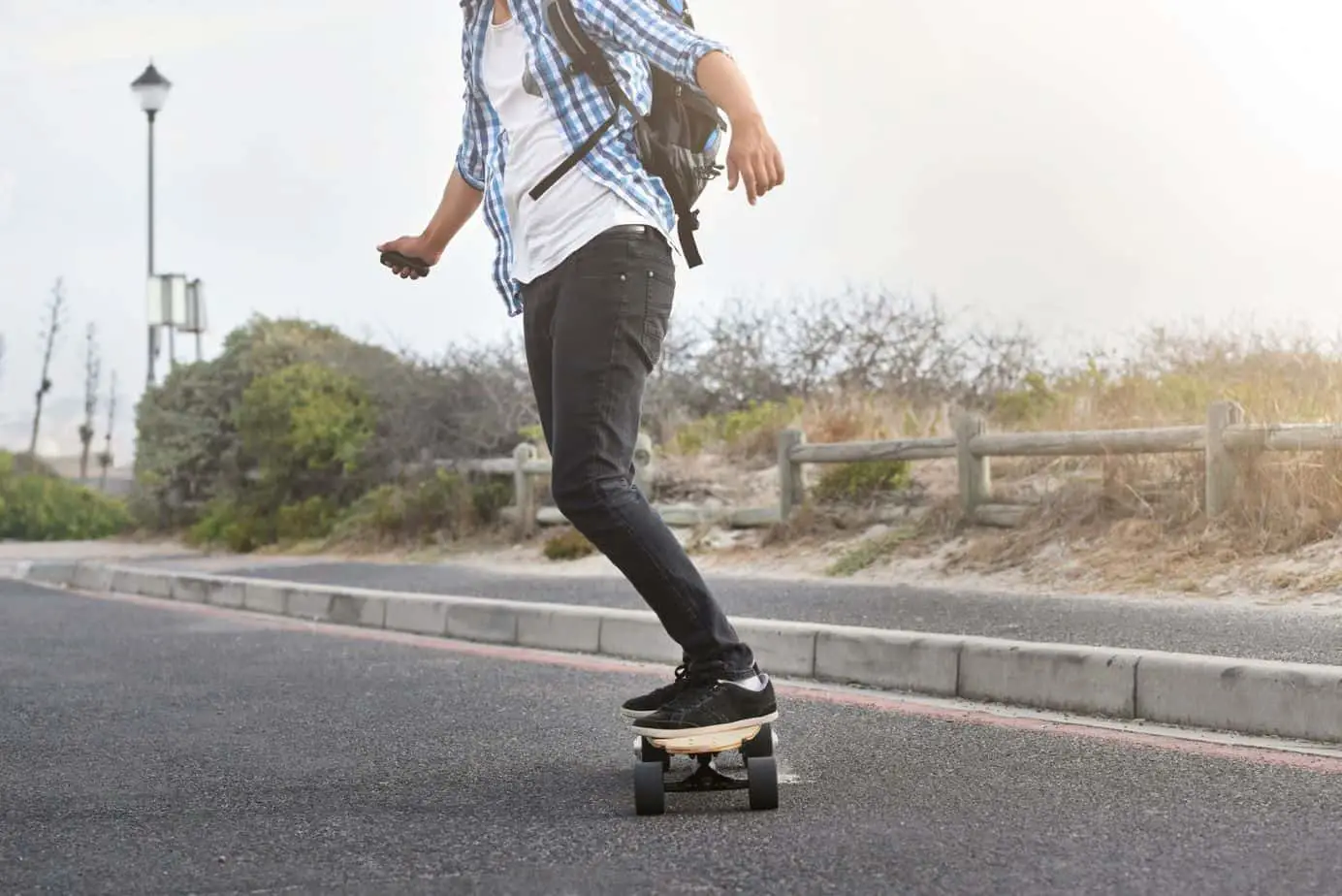If you are considering buying an electric skateboard, chances are that you’re concerned about the device’s safety features. The good news is that electric skateboards have breaks. Of course, the details on how you should use those brakes and what type of skateboard braking system is the best are a separate matter altogether.
Why do electric skateboards have brakes?
The idea of skateboard brakes may seem foreign to you, but know that they are extremely important. After all, electric skateboards have become so popular in recent years because you can drive them at such high speeds.
With their efficient lithium-ion batteries, top-of-the-line skateboards can go up to 28 mph, which equals the speed of most scooters and electric bikes. Without brakes to help you stop your boar, many people would hurt themselves, falling off their fast boards. So naturally, safety features are a priority for e-board companies.
How does an electric skateboard work?
How to start your board?
Now you may be wondering how an electric skateboard differs from a normal skateboard. The first difference is the acceleration process. With an e-board, you don’t need to kick your foot to drive it because that’s what the motor is for. So all you need to do is open the throttle and use the remote to manage your speed. And you can travel on your board effortlessly.
Generally, you can use it to travel short distances within your locality of the city. While the specifics vary depending on the board company and model, most e-boards weigh between 25 to 50 pounds and can go up to 18 to 35 mph.
How to stop your board?
Then there’s the break. Again, when you’re going upwards of 28 mph, you need a way to slow down or stop your board if you need to. That means knowing what type of braking system you have and how it works. Some boards, particularly those with regenerative systems, may require you to slow down the board with your foot. While others are fully automated at all times.
How to steer your board?
In most cases, the battery and motor will be underneath your deck. However, some boards have their motors within their wheels. While you’re steering your board, look out of obstacles or hurdles that may hit your board or upset its mechanism.
Overall, steering an e-board is no different from steering a regular board. You simply use your bodyweight and tilt it to the side you want it to turn. People who are used to skateboarding will find the transition from regular boards to e-boards effortless.

How do you brake on an electric skateboard?
Before you can get on an electric skateboard, you need to know how it works and, more importantly, how to use the brakes. Otherwise, you’re a safety hazard for both yourself and other people on the sidewalk. So how exactly do you use your skateboard brakes?
Despite all the fuss, skateboard braking is relatively simple. The remote will let you increase or decrease the speed, stop the board entirely and even check battery levels. However, fair warning, if you flick the switch too fast while driving at high speed, it will stop instantly. This will propel you forwards, which can be dangerous. Instead, pull back slowly and ease into it the same way you would with a car.
Types of Braking Systems
Understanding your braking system is a crucial stage in learning how to work an e-board. There are three main types of skateboard brakes.
Friction brakes
Friction brakes are the most traditional and old-school style of brakes found in cars and bikes. And they work on skateboards in pretty much the same way. The frictional force against the disc changes the kinetic energy into heat energy, slowing it down till it comes to a stop.
While you can find friction brakes in older skateboards, you’ll be hard-pressed to find them in newer models. Some niche brands may still use them, but most bigger companies have moved onto newer systems.
Dynamic brakes
The most common label you find is “outrunner brushless motor.” Don’t let this confuse you. While this isn’t necessarily a braking system, it is the basic technology that dynamic and regenerative brakes use. Here’s how it works.
The motor itself is made of a copper core, which is usually wound wire. Around it is a set of magnets. Running a current through the core triggers the formation of a magnetic field. The field jump-starts the magnets which work the motor. If that sounds familiar, it’s because you’re building an electromagnet the same way students learn how to in high school.
However, there’s a second scenario where instead of running an electric current through the copper core, you rotate the pair of magnets to induce an electric charge. This simple system forms the backbone of dynamic and regenerative brakes.
Regenerative brakes
Dynamic and regenerative brakes both create current in the same way but use it differently. With a dynamic system, pressing the brake pushes the current into a resistor. That breaks the flow of energy, creating heat that stops the board.
On the other hand, a regenerative system pushes the excess energy back into the battery. That way, you never have to worry about charging our e-board. However, this leads to the question of what happens once the battery is fully charged. Simple, the board will stop braking.
Tips on how to learn to brake
Learning how to brake relies heavily on knowing what type of system you have. For example, if your board uses a mix of both dynamic and regenerative brakes, you’ll hear a beeping sound to warn you when you’re about to lose braking ability. With these types of systems, the board automatically switches to dynamic braking when the battery is full.
However, if your board is fully regenerative, you need to know that your brakes will eventually cut out. That means learning how to foot brake at even high speeds—or managing the speed of your board once you lose braking ability.
Conclusion
At the end of the day, if you or someone you know are planning on purchasing an electric skateboard, rest assured that it is perfectly safe. No matter what brand or model you go with, you can be confident that professionals have tested the skateboard brakes, and there is little risk of them malfunctioning.
Now that you know how skateboard brakes work, what types you can expect, and why they matter, you are ready to go out and buy your very first e-board. Good luck!
If this article was helpful, sign up for our Newsletter for more great content.

